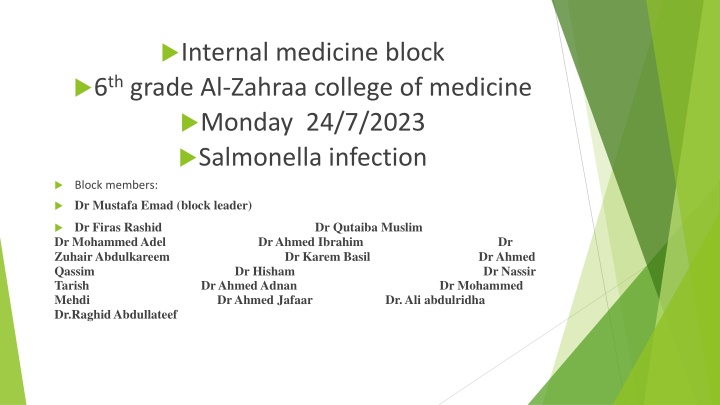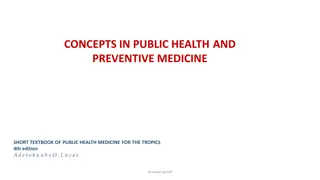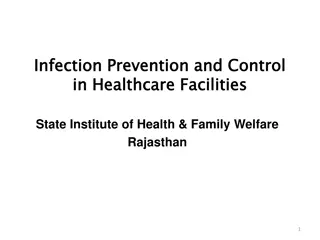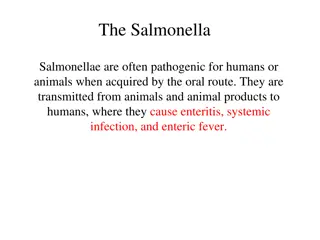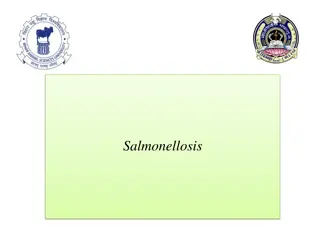Salmonella Infection Overview at Al-Zahraa College of Medicine
Salmonella infections, caused mainly by Salmonella serovars, are discussed in relation to transmission, etiology, and pathophysiology. The presentation includes information on Salmonella Typhi and non-typhoidal Salmonella strains primarily affecting humans. Learn about the sources of contamination, host defense mechanisms, and factors influencing infection development.
Uploaded on Apr 22, 2025 | 0 Views
Download Presentation

Please find below an Image/Link to download the presentation.
The content on the website is provided AS IS for your information and personal use only. It may not be sold, licensed, or shared on other websites without obtaining consent from the author.If you encounter any issues during the download, it is possible that the publisher has removed the file from their server.
You are allowed to download the files provided on this website for personal or commercial use, subject to the condition that they are used lawfully. All files are the property of their respective owners.
The content on the website is provided AS IS for your information and personal use only. It may not be sold, licensed, or shared on other websites without obtaining consent from the author.
E N D
Presentation Transcript
Internal medicine block 6thgrade Al-Zahraa college of medicine Monday 24/7/2023 Salmonella infection Block members: Dr Mustafa Emad (block leader) Dr Firas Rashid Dr Qutaiba Muslim Dr Mohammed Adel Dr Ahmed Ibrahim Zuhair Abdulkareem Qassim Dr Hisham Tarish Dr Ahmed Adnan Mehdi Dr Ahmed Jafaar Dr.RaghidAbdullateef Dr Dr Karem Basil Dr Ahmed Dr Nassir Dr Mohammed Dr. Ali abdulridha
Salmonellae infection
They can be differentiated into more than 2500 serovars by their somatic (O) antigens, which are composed of lipopolysaccharides and are part of the cell wall, Members of the family Enterobacteriaceae , salmonellae are gram- negative, non-spore- forming bacilli.
Salmonella Typhi, Salmonella Para typhi A, Salmonella Para typhi B, Salmonella Para typhi C are either solely or almost exclusively pathogens of humans. they cause primarily enteric fever rather than diarrhea, and transmission is usually through water or food. As a result of modern sewage and water treatment facilities and improved food safety practices. Other serovars of Salmonella (described here as nontyphoidal Salmonella) have reservoirs in warm-blooded animals and cause human illness after the consumption of contaminated meat or animal product.
Etiology Salmonellae are transmitted by the ingestion of fecally contaminated food or water; contact with animals, their environments, and other fomites. Rarely, close contact with infected persons. The ultimate sources of contamination are humans or animals that are acutely ill or are shedding the organism without symptoms.
Pathophysiology After the ingestion of organisms, the likelihood for development of infection, as well as the severity of infection, is related to the dose, the virulence of the Salmonella strain, and the status of host defense mechanisms. Gastric acid serves as a host defense mechanism by killing many of the ingested organisms, and intestinal motility is probably another host defense mechanism. Administration of antimicrobial agents before the ingestion of salmonellae can markedly reduce the size of the inoculum needed to produce infection, presumably by reducing the concentration of protective bowel flora
To produce infection, invasion must occur across the mucosa of the intestine. When the organisms reach the lamina propria, an influx of polymorphonuclear leukocytes serves as a host defense mechanism to prevent invasion of the lymphatics. Patients with diseases that impair host defense mechanisms seem to have an increased frequency of severe Salmonella infection. A striking association has been recognized between diseases producing hemolysis and Salmonella bacteremia. Specifically, Salmonella bacteremia is common in patients with sickle cell disorders, malaria,
In fact, because of the frequency of Salmonella bacteremia in sickle cell diseases and the underlying bone disease in these patients to which salmonellae localize, these organisms are the most common cause of osteomyelitis in patients with sickle cell disorders
CLINICAL MANIFESTATIONS Asymptomatic Intestinal Carrier State The asymptomatic intestinal carrier state may result from inapparent infection (which is the most common form of Salmonella infection), or it may follow clinical disease (in which case the patient becomes a convalescent carrier). The carrier state is usually self-limited to several weeks to months, with the prevalence of positive stool cultures rapidly decreasing over time. By 1 year, far less than 1% of carriers still have positive stools.
Enterocolitis After an incubation period of usually 12 to 48 hours, the illness starts suddenly with crampy abdominal pain and diarrhea. Nausea and vomiting may occur but are usually not prominent or persistent. The diarrhea may be watery and of large or small volume. Stools may contain mucus and are occasionally bloody. The temperature may reach 40 C (104 F) or higher Symptoms generally improve during a period of days, with fever lasting no more than 2 to 3 days and diarrhea lasting no more than 5 to 7 days. However, these symptoms occasionally persist for up to 14 days.
Enteric fever Enteric fever is produced by Salmonella Typhi (typhoid fever), Salmonella Paratyphi A, B, and C (paratyphoid fever), and occasionally other serovars. Sometimes it immediately follows classic enterocolitis caused by the same organism. The syndrome is characterized by prolonged, sustained fever and may be associated with relative bradycardia, splenomegaly, rose spots, and leukopenia.
The following is a description of untreated illness: After an incubation period of 5 to 21 days (generally 7 to 14 days), fever and malaise develop, often associated with cough. A small proportion of patients may have diarrhea during the incubation period. The fever tends to rise in a stepwise fashion during the first few days to a week and then becomes sustained, usually at 39.4 to 40.0 C (103 to 104 F) or higher
Relative bradycardia is seen in up to half of patients. Apathy, confusion, delirium, and even psychosis may occur. Abdominal distention, pain, and tenderness may occur in the first week and may be associated with diarrhea or constipation; these symptoms are generally more pronounced during the second week of fever. Most patients have abdominal tenderness during the illness. In about 30% of patients, rose spots develop on the abdomen or chest (or both) toward the end of the first week or during the second week of fever.
Salmonellae can be cultured from punch biopsies of these lesions. Hepatosplenomegaly occurs in about half of patients. Leukopenia and neutropenia are seen in about 20%. Abnormal liver function test results are common. After 2 weeks of illness, the severe complications of intestinal hemorrhage and perforation related to necrosis of Peyer patches may be observed in about 5% of patients.
Intestinal perforation is the leading cause of death from enteric fever. The illness usually resolves by the end of the fourth week in an untreated patient. Relapse may occur in untreated as well as in treated patients, but the illness is milder than the original episode.
Bacteremia Patients with Salmonella bacteremia usually complain of fever and chills lasting days to weeks. Gastrointestinal symptoms are unusual, but in some patients Salmonella bacteremia follows classic enterocolitis. Other symptoms are nonspecific, such as malaise, anorexia, and weight loss. Metastatic infection is common, and symptoms may be related to the site of metastatic infection. Stool cultures are often negative for salmonellae, but blood cultures are positive
Diagnosis Stool culture is definitive for the diagnosis of Salmonella enterocolitis, but by the time the results of stool culture are available, most patients are recovering. Culture-independent methods, including panel-based multiplex molecular diagnostics from stool specimens, are used increasingly by clinical laboratories. The differential diagnosis of Salmonella bacteremia includes virtually all acute infectious and noninfectious causes of fever, including bacteremia caused by other organisms. The diagnosis is proved by isolation of the microorganism from blood or from another normally sterile site.
The diagnosis of enteric fever is best proved by isolation of the microorganism from blood, stool, or bone marrow. During the first week of illness, blood cultures are positive in about 90% of patients, but culture positivity decreases in the next 2 weeks to less than 50% during the third week of illness. Stool cultures are usually negative during the first week but are generally positive by the third week. Bone marrow cultures give the highest yield, with up to 95% being positive; they should be considered in suspected cases with negative blood cultures.
Bone marrow cultures may be positive even after several days of antimicrobial treatment, when blood cultures have become negative. Urine cultures and cultures of punch biopsies of rose spots may also be positive. The peripheral leukocyte count is usually normal, but leukopenia, which occurs in about 20% of cases, may be suggestive of enteric fever. Fecal leukocytes are generally present The Widal and other serologic tests that detect serum antibodies against Salmonella Typhi are limited by shortcomings of both sensitivity and specificity and rarely provide useful information to guide management of the patient.
Enterocolitis The primary approach to the treatment of Salmonella enterocolitis is fluid and electrolyte replacement. Drugs with anti-peristaltic effects, such as loperamide or diphenoxylate with atropine, can relieve cramps, but they should be used sparingly because they can prolong the diarrhea. Salmonella enterocolitis is self-limited, and antimicrobial therapy is usually not indicated, except perhaps in groups of patients at high risk for invasive disease.
The fluoroquinolones are active against virtually all bacterial pathogens that cause diarrhea (including salmonellae), except for C. difficile and many Campylobacter organisms. Thus, it is reasonable to use fluoroquinolones for patients with suspected or known Salmonella enterocolitis who are severely ill and suspected of being bacteremia. The threshold for antimicrobial treatment is also decreased in those at increased risk for severe illness (e.g., infants, the elderly, patients with sickle cell disease, immunosuppressed individuals)
The fluoroquinolones remain agents of choice for the treatment of enteric fever in many parts of the world. Ciprofloxacin (500 mg orally twice a day) for 7 to 14 days has been the fluoroquinolone of choice for enteric fever. If a patient cannot tolerate oral therapy, the fluoroquinolones can be administered intravenously. If decreased fluoroquinolone susceptibility or resistance is suspected or demonstrated, alternative agents include extended- spectrum cephalosporins (e.g., intravenous ceftriaxone) and azithromycin. The agents of choice to treat Salmonella bacteremia are the fluoroquinolones, such as ciprofloxacin, and the extended- spectrum cephalosporins, such as ceftriaxone.
Patients often require supportive care with intravenous saline, correction of electrolyte and acid-base disturbances, and, in the setting of intestinal bleeding, blood transfusion. If perforation is suspected, abdominal imaging should be performed to evaluate for free air. If perforation seems likely, laparotomy should be performed as soon as possible to repair the perforation. Steroid therapy is beneficial in some patients with severe enteric fever and coma, delirium, or shock.
Prevention Salmonella infection is best prevented by protecting the water supply, preventing fecal contamination during food production, cooking and refrigerating foods, pasteurizing milk and milk products, and handwashing before preparing foods There is no vaccine for Salmonella infection other than that for Salmonella Typhi. Travelers should be vaccinated before going to areas that are endemic for typhoid fever
